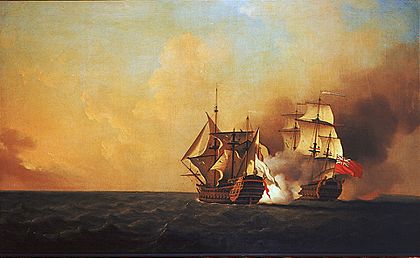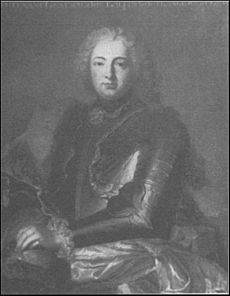Duc d'Anville expedition facts for kids

The Duc d'Anville expedition was a huge French military plan. It took place from June to October 1746. Its main goal was to take back Louisbourg and Acadia (which is now mainland Nova Scotia) from the British.
This expedition was the biggest military force ever sent to the New World. It happened before the American Revolutionary War. It was also the fourth and final time France tried to recapture Annapolis Royal, the capital of Nova Scotia, during King George's War. A land force from Quebec, led by Jean-Baptiste Nicolas Roch de Ramezay, was supposed to help.
Besides taking back Acadia, the leader, Duc d'Anville, was told to "burn Boston, attack New England, and destroy the British West Indies." News of this huge plan made people in New York and New England very scared.
However, the expedition was a complete failure. It faced terrible weather and took three months to cross the Atlantic Ocean. Many sailors and soldiers got sick and died before the ships even reached Chebucto Bay (now Halifax Harbour). Duc d'Anville himself died soon after they arrived. The leaders who took over tried to attack Annapolis Royal, but they eventually gave up. The remaining ships and men returned to France.
The poet Henry Wadsworth Longfellow wrote about this expedition in his poem A Ballad of the French Fleet.
Contents
Why This Expedition Happened
The British had captured the capital of Acadia in 1710. They renamed it Annapolis Royal. For the next 50 years, France and its allies tried six times to get the city back. The Duc d'Anville expedition was the last big French attempt.
King Louis XV of France sent this expedition during King George's War. It came after France suffered a big loss at the siege of Louisbourg (1745). This new plan was meant to work with Ramezay's land force from Quebec.
Getting Ready for the Journey
The expedition was massive. It included 11,000 men and a fleet of 64 ships. French Admiral Jean-Baptiste Louis Frédéric de La Rochefoucauld de Roye, Duc d'Anville, was in charge. Getting all the ships and supplies ready was slow and difficult. The fleet finally left Île-d'Aix, France, on June 22, 1746.
Soon after, a storm in the Bay of Biscay and bad winds slowed their trip across the Atlantic. Diseases like typhus and scurvy broke out on the ships. The fleet then hit a long period of no wind near the Azores. This calm ended with another storm. Lightning struck several ships. In one case, an explosion in a ship's gunpowder storage killed or wounded over 30 men. By August 24, the expedition had been at sea for more than two months. They were still far from Nova Scotia.
On September 10, the first ships reached Sable Island. Three days later, a strong storm scattered the vessels. Some ships were badly damaged and had to return to France. One of these was Le Mars (shown in the painting above). It was heavily damaged and taking on water. Le Mars tried to return to France with another ship, Le Raphael. Weeks later, another storm hit. This damaged Le Mars even more and separated it from Le Raphael. In October 1746, the British ship Nottingham|1703|6 attacked Le Mars and captured it. The British Navy added it to their fleet as HMS Mars.
Meanwhile, a land expedition led by Jean-Baptiste Nicolas Roch de Ramezay was sent from Quebec. They were supposed to meet up with d'Anville's fleet. A French priest named Jean-Louis Le Loutre was to help coordinate the two groups. De Ramezay's force arrived in Nova Scotia in July 1746. He had 700 soldiers and 21 officers. He set up camp at Beaubassin. There, he met 300 Abenaki warriors from the St. John River and about 300 Mi'kmaq warriors from Nova Scotia. This made the total French-Indigenous force nearly 1,300 men.
De Ramezay's soldiers spent the summer and early fall waiting for d'Anville's fleet. They waited at Chignecto and Minas. During this time, de Ramezay sent troops to Port-La-Joye (on what is now Prince Edward Island). In a fierce fight there, de Ramezay's men killed 34 British soldiers and captured the rest.
Arrival in Nova Scotia
The d'Anville expedition finally reached Nova Scotia in late September. Their journey had lasted three months. Hundreds of sailors and soldiers had died. Many more were very sick with diseases. Forty-four ships anchored in Chebucto (now Halifax). The expedition would stay there for the next five weeks.
The sick were brought ashore near Birch Cove. Some recovered from scurvy because Acadians brought fresh supplies from Grand Pre and Pisiquid. But typhus and typhoid continued to spread among the men.
Just six days after arriving, on September 27, Duc d'Anville died from a stroke. He was buried on Georges Island in Halifax Harbour. His remains stayed there for three years. Later, they were moved to Louisbourg in September 1749.
On September 29, a meeting of war leaders decided to send 1,500 men from the fleet and 300 from Ramezay's group to attack Annapolis Royal. But d'Anville's replacement, Constantin-Louis d'Estourmel, felt overwhelmed and quickly resigned.
The next person to take control was Jacques-Pierre de Taffanel de la Jonquière, Marquis de la Jonquière. He was supposed to become the Governor General of New France. The plan to attack Annapolis Royal became even more serious, even as men continued to die from disease. By mid-October, 41 percent of the men who reached Chebucto were dead or very sick. This was 2,861 officers, sailors, and soldiers. The sickness also spread to the Mi'kmaq and de Ramezay's men.
By mid-October, 300 of de Ramezay's troops arrived at Annapolis Royal. The French and Indigenous fighters camped in the Annapolis area for 21 days. They waited for the French ships to arrive with more troops and large cannons for a siege. They cut off British land communication with Minas. They also tried to stop any contact between the fort and the Acadians.
On October 24, 42 ships left Chebucto. They had almost 50 Acadian pilots from Minas. Three hospital ships sailed for France with the most critically ill. Thirteen of the ships carried 94 officers and 1,410 soldiers for the attack. Two days later, when the fleet was near Cape Negro, Nova Scotia, La Jonquière changed his mind. He ordered his ships to return to France. He also sent orders to Annapolis Royal for de Ramezay to leave.
What Happened Next
Because of the threat from the French expeditions, Massachusetts Bay Governor William Shirley sent Colonel Arthur Noble and hundreds of New England soldiers. Their job was to secure Acadia and drive de Ramezay out.
One of de Ramezay's successes was when Nicolas Antoine II Coulon de Villiers defeated Colonel Noble. This happened at the Battle of Grand Pré in 1747. De Villiers attacked and defeated a larger force of Noble's soldiers. These soldiers were staying in houses in the Acadian village of Grand-Pré, Nova Scotia, in the Minas Basin.
The failure of the French expedition had big effects on how Acadians took part in the rest of the war. Any hope Acadians had that France would win was shaken. After the expedition, Nova Scotia Governor Paul Mascarene told Acadians to avoid any "false hopes of returning under the rule of France." One French officer noted that when de Ramezay left Annapolis Royal, the Acadians were worried and disappointed. They felt abandoned by the French authorities.
The diseases from the French crews also spread among the Mi'kmaq people, killing hundreds of them.
The last major battle in the Annapolis Royal area during this time was the Battle of Bloody Creek (1757), during the French and Indian War.
Legacy
- The Duc d'Anville expedition is the namesake of Duc d'Anville Elementary School in Halifax, Nova Scotia.
- The place where Duc d’Anville's camp was in September 1746 became a National Historic Site of Canada in 1925.
Images for kids




